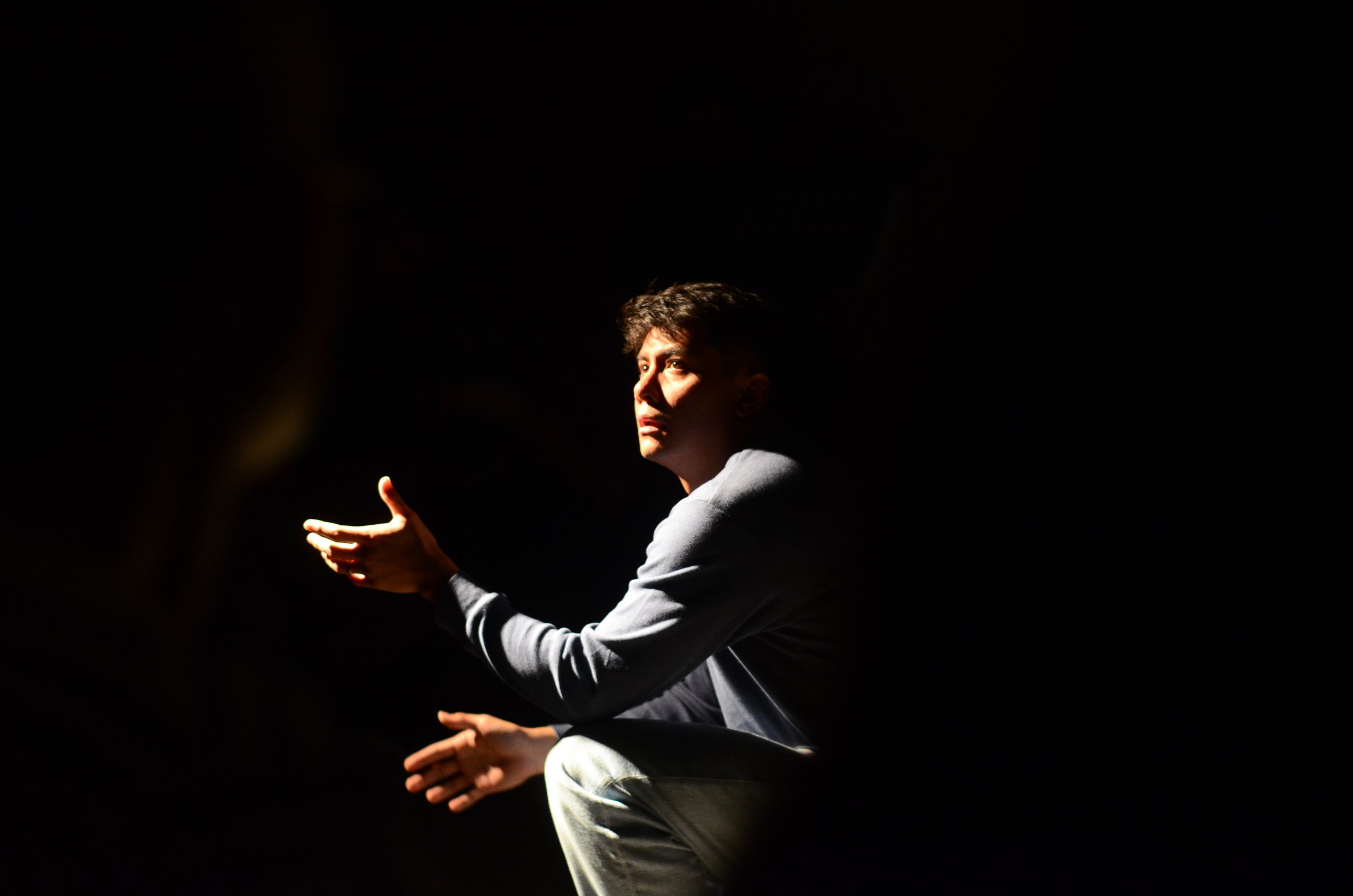‘3 Upuan’ REVIEW: Spare Staging Gives Way to Unsparing Expression of Grief
‘3 Upuan’ REVIEW: Spare Staging Gives Way to Unsparing Expression of Grief
Photo by Jaypee Maristaza
A decade ago I started a new semester in our college’s new building. It was shiny and tall, something then that would more likely be seen standing among Ortigas or Makati skyscrapers than the low, colorful buildings of Manila. Here I had class in one of the rooms that seemed as much capable of hosting presentations or possibly performances, but more realistically was used for class discussions. Parabolic, fluorescent white lights lit the room and its white walls in a workman-like manner. Like any setting, it was a room that could be informative, tense, sometimes boring, or a spot to catch up with classmates in between classes.
Recently I found myself in a room at the Areté in Ateneo de Manila, walking towards seats with a runny nose and a dry throat to watch 3 Upuan, a stage play written and directed by Guelan Varela-Luarca. It looks almost like the classroom I was in back then, but there’s no teacher’s table in front of me— just three different chairs.
In a place like the Areté, with spaces that could house hundreds, it may seem unusual for a story of three siblings navigating life and death as elder millennials to be staged in such an intimate space that could only seat fewer than a hundred people in a given show. Aside from the titular three chairs, there are no other props. Just the actors and as I’ll later find, projection to further extend the characters’ ideas and shadows. It’s a big ask from debut theater company Scene Change to request their audience to sit with the ideas and feelings they’ll unload with as little to go on visually as possible.
The three characters of 3 Upuan make their way into the room almost as if they’re audience members. But once they’re positioned in their seats, Jai (Martha Comia) starts conjuring memories and feelings of time and grief. It’s a gentle easing in of what the play’s thematic fixations will be, before taking us through the days that Jai’s brothers, Jers (Jojit Lorenzo) and Jack (JC Santos), are watching over their father in the hospital. The whiplash of emotions and discussions—days of crying, of boredom, of the mundane and various topics—blazes ahead without a sense of structure. These changing days are marked only by a verbal narration of time passing by. Its simplicity ends on a discomforting note when the two brothers’ far-reaching discussions touch upon euthanasia, revealing their different relationships with death, and the first instance among many, of the play’s sparse staging leaving room for its unsparing expression of grief to land fully.
The play’s story is expounded on soon after. Jai, after years of living in New York, returns to the Philippines to visit her cancer-stricken father and two brothers, Jers and Jack. This visit will not last long, and much as they’re bonded by their family history, they have never been more far apart from each other than ever. On the surface, the grief they’re preparing for is their father’s impending passing. But their time together also becomes a way of grieving their passions passing by. Jai and Jack are both repressed creatives who chose jobs with more visible income and contributions instead of following their passions—Jai, her dancing, and Jack, his desire to draw and create worlds out of them. Jers seems the most professionally fulfilled with his teaching, but even that serves as a way of using his genius to cover up his own vulnerability.
Photo by Jaypee Maristaza
Varela-Luarca trusts his actors so much to remain on the stage as the story shifts between the trio. The three leads’ dedication to the staging’s demands makes each of their individual scenes richer. Their handful of scenes together, then, increasingly gain bittersweet resonance, a feeling drawn from the experience of seeing people you grew up with so closely less and less over time as you also grow more differently from the versions of each other that first bonded you. A scene with Jack exemplifies this, showing the days where he gets sentimental in his parents’ graves. It’s one of those unsparing explorations of grief I brought up that Santos wears with the weight of time so skillfully.
Lorenzo’s Jers comes alive during the lecture scenes, which punctuate the play’s narrative with insightful philosophical discussions. These are presented partly with projected lights, transforming the audience into students themselves. These moments serve as a way of inviting the audience to muse on the play’s ideas before the sight of the three siblings under these projected lights serve as a means to take them out of time.
With that, it’s Lorenzo’s more quiet moments that linger in my head. Take a late moment in the play where he’s resigned to death, when its distant idea becomes an impending reality to him. The millennial generation is getting older and time and its effects are weighing more heavily on these bodies. Jers’ clear, resigned acceptance feels like its own morbid coming-of-age, though it’s not for the young twentysomething but the older fortysomething staring down the barrel of what his life has amounted to and adapting the grief for those he’s lost into the grief of his loss he’s worried about leaving to his loved ones.
Photo by Irvin Arenas
It’s Comia’s Jai that the play gives space to run the emotional gamut of a woman forced to move away from her family in the name of progress. She comes back to a country and a family periodically and watches the changes happening around their own stagnation in their life as she flies in and out. It’s something Jai herself experiences when she confronts a cheating partner, ultimately admitting she’ll still stay anyway. It’s a pain Comia keys into with subtle precision, especially in a dancing sequence where the catharsis is cut short by her body that can’t catch up to her soul’s artistry.
Another insightful moment sees the well-traveled Jai, now more a stranger to her country’s Tagalog, finding herself lingering on the pain embodied by the words “na rin” (which, in its English context in the play probably would’ve been translated as “too”). How those two words add a heavier burden of loss onto Jai at a vulnerable moment is among many of its wise moments, showing how even Filipinos distant from their culture and identity can still locate the pain in its words.
As Jai’s grief turns towards acceptance, the play’s relationship to time changes. Its structure also gives way as the siblings become unbound by time. This is where 3 Upuan reaches further towards the existential in making historical connections across generations. In 3 Upuan, its musings and sentiments reward the audience at the end with its own emotional release. It’s this section that I wish I could spend more time with, seeing the actors embody the five stages of grief enveloped by one projector’s light. The simplicity of it all allows its visual imagination to let audiences project their own memories and grief onto the play.
Photo by Jaypee Maristaza
This staging of 3 Upuan is Scene Change’s second run of the show. There is intent for the show to conduct future stagings in intimate spaces. It’s clear that people have connected with its story, and their confidence in keeping its story in such spaces may be different enough just to work. This kind of trust in the play’s story and its actors’ talents is ready to reward those seated in its theatrical space.
At the end as I watch the actors take their bow, I am healed. Still in need of tissues and water, but healed enough to believe in life after love—or at least to keep working for it through the time spent with and away from the ones we love.





















